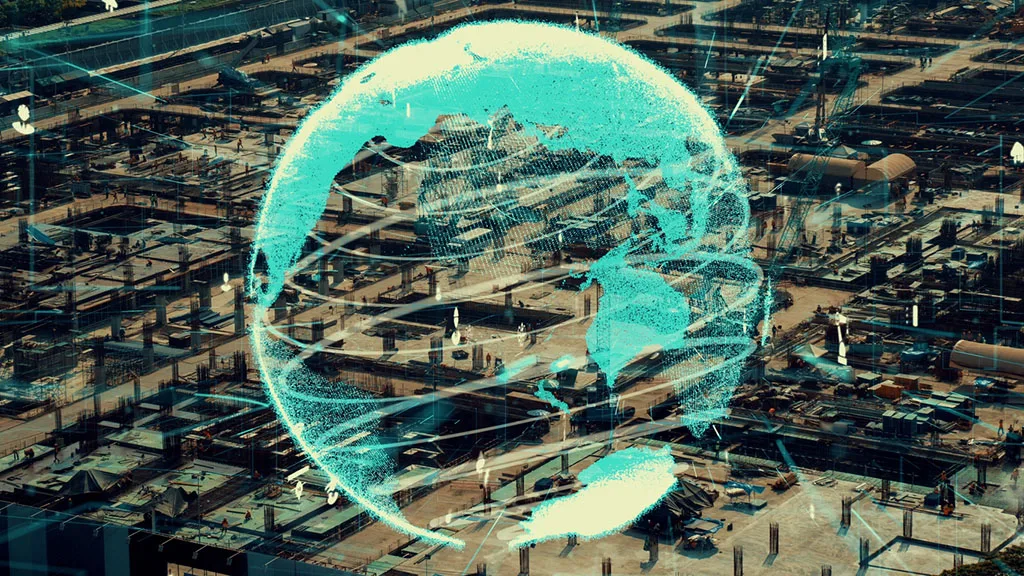



The artificial intelligence revolution demands unprecedented infrastructure investment, with $7 trillion in global AI infrastructure spending projected through 2030. This massive buildout represents the largest construction opportunity since the interstate highway system, with individual data center projects routinely valued at $500 million to $2 billion. The race to build AI-capable infrastructure is creating fundamental shifts in how we approach data center construction, power delivery, and cooling systems.
The market momentum is undeniable. Data center construction spending reached $31.5 billion in 2024 alone, driven by hyperscalers like Meta, Google, and Amazon deploying AI workloads that consume 10 times more power than traditional computing. This surge creates both unprecedented opportunities and complex engineering challenges that require specialized construction expertise to navigate successfully.
AI data centers fundamentally differ from traditional facilities in their power requirements. Where conventional data centers operate at 6-15 kW per rack, AI infrastructure demands 60-100 kW per rack, with some specialized GPU clusters reaching 300 kW. This intensity requires entirely different approaches to electrical infrastructure, cooling systems, and structural design.
The 165% increase in power demand projected by 2030 forces data center developers to rethink every aspect of facility design. Traditional 208V electrical systems give way to 415V distributions to handle the increased load. Cooling systems must evolve beyond conventional air handling to direct-to-chip liquid cooling and immersion technologies. These changes demand construction teams with deep expertise in mission-critical systems and cutting-edge cooling integration.
Power infrastructure constraints are extending construction timelines nationwide. Grid connection wait times now stretch 4-7 years in key markets like Northern Virginia, making alternative power solutions critical. Small modular reactors (SMRs) and dedicated natural gas plants are emerging as primary strategies, with Amazon, Google, and Meta announcing partnerships for 600+ MW of nuclear capacity. Success in this market requires early coordination with utilities and alternative power providers.
The shift to liquid cooling represents the most significant change in data center construction in decades. Direct-to-chip liquid cooling systems can handle 70-75% of rack heat loads while reducing total facility power consumption by 15%. Implementation requires specialized installation of cold plates, coolant distribution units, and dielectric fluid systems that demand precision construction techniques.
Immersion cooling technologies achieve even greater efficiency gains, with Power Usage Effectiveness (PUE) ratings as low as 1.02 compared to industry averages of 1.55. These systems submerge entire servers in specialized dielectric fluids, requiring custom-designed enclosures, leak protection, and maintenance access systems. The 50% energy reduction potential makes immersion cooling essential for the highest-density AI workloads.
ROI analysis reveals compelling advantages for liquid cooling at scale. Schneider Electric research demonstrates 14% capital expenditure savings at 40kW rack densities through elimination of traditional chillers and air handling systems. Operational benefits include 41-80% reduction in server fan power requirements and significantly improved equipment reliability through stable thermal conditions.
The urgency of AI infrastructure deployment is driving rapid adoption of modular construction approaches. Modular data centers deploy 30-50% faster than traditional construction, with assembly times of 4-6 months compared to 18-24 month conventional builds. This speed advantage proves critical when hyperscalers are spending $125 billion annually on AI infrastructure.
Beyond speed, modular construction offers scalability advantages that align with AI workload growth patterns. Pay-as-you-grow deployment models allow operators to add 15-25 MW tranches without major construction disruption. Pre-fabricated modules undergo factory testing and commissioning, reducing on-site risk and ensuring consistent performance parameters.
The cost advantages compound over project lifecycles. Factory efficiencies enable up to 30% construction cost reduction through bulk material purchasing and controlled manufacturing environments. Quality control improvements and reduced weather-related delays further enhance project economics, making modular approaches increasingly attractive for large-scale AI infrastructure.
Major cloud providers are rapidly expanding beyond traditional data center hubs, creating opportunities in secondary markets. Amazon, AWS, announced a $10 billion investment in North Carolina, while Meta’s Louisiana campus represents a $10 billion commitment to Southeast expansion. These projects highlight the shift toward regions offering power availability, favorable regulations, and specialized construction capabilities.
Hurricane-resilient construction in Puerto Rico, North Carolina, and Florida presents unique advantages for specialized contractors. Puerto Rico’s Act 60-2019 offers 4% income tax rates for qualifying technology investments, while Florida’s post-Hurricane Andrew building codes represent the world’s strictest wind-resistant standards. These markets demand construction expertise in impact-resistant materials, redundant power systems, and enhanced structural requirements.
The geographic diversification strategy addresses power constraints in traditional markets while accessing lower-cost electricity and land. Secondary market projects in Ohio, Indiana, and Missouri are seeing massive investment, with Google’s Fort Wayne facility representing a $2 billion commitment. Success requires understanding local regulatory environments, utility partnerships, and specialized workforce development.


The $720 billion global investment needed in transmission and distribution infrastructure creates parallel opportunities beyond data center construction itself. Utility partnerships for dedicated substations, transmission line upgrades, and alternative power generation represent substantial project values for specialized contractors.
Grid modernization efforts focus heavily on reliability and redundancy requirements for AI workloads. Tier III and Tier IV uptime standards demand N+1 and 2N+1 redundancy systems that must maintain 99.982% and 99.995% availability respectively. These requirements drive sophisticated backup power systems, multiple utility feeds, and on-site generation capabilities.
Emergency power systems for AI data centers require significantly enhanced capacity compared to traditional facilities. Where conventional data centers might operate on battery backup for 15 minutes during utility transfers, AI workloads demand extended runtime capabilities and seamless transitions to protect continuous training operations worth millions of dollars.
The $7 trillion AI infrastructure buildout represents a generational opportunity for construction companies with specialized capabilities in power systems, advanced cooling, and mission-critical facilities. Success requires understanding the fundamental differences between AI and traditional data center requirements, from 10x higher power density to revolutionary cooling technologies.
CIC Construction Group’s expertise in industrial and advance technologies construction positions us uniquely for this market expansion, particularly in the strategic North Carolina, Puerto Rico, and Florida regions where hyperscalers are investing billions. Our proven capability to manage complex, high-value projects aligns perfectly with the $500 million to $2 billion project scales driving this market transformation.
The convergence of modular construction advantages, advanced cooling requirements, and specialized power infrastructure creates an ideal environment for contractors who can navigate technical complexity while delivering on aggressive timelines. As AI workloads reshape global computing infrastructure, the construction expertise developed today will define market leadership for decades to come.
Ready to capitalize on the AI infrastructure boom? Contact CIC Construction Group to discuss your data center project requirements and discover how our specialized expertise can accelerate your development timeline while ensuring mission-critical reliability standards.